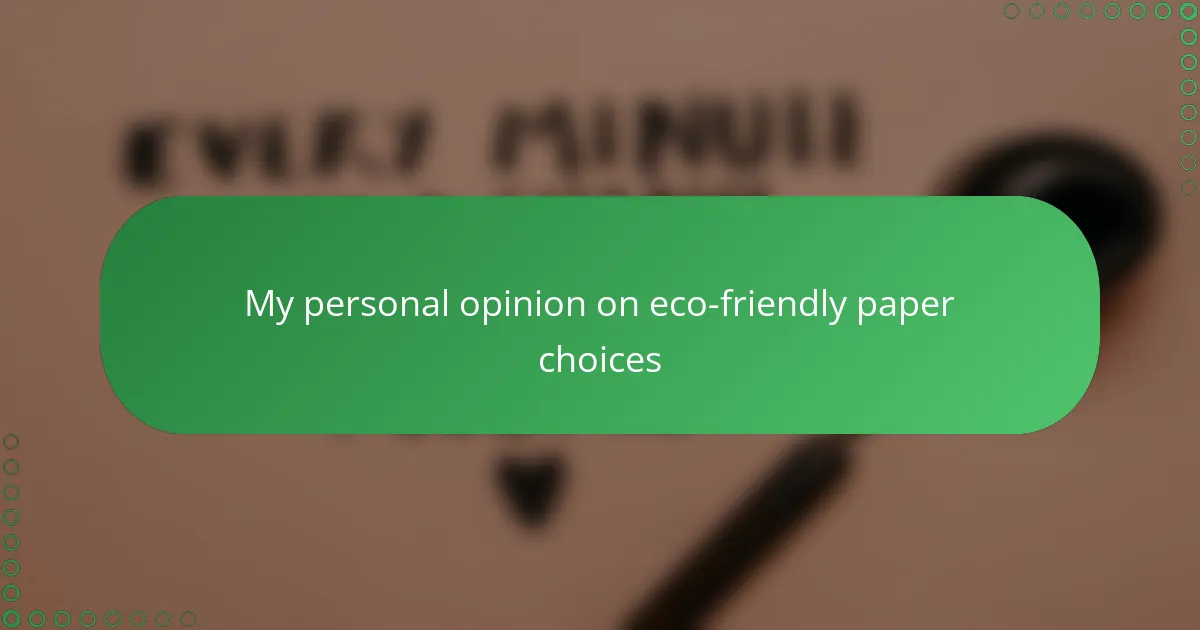Key takeaways
- Eco-friendly paper options are diverse, including recycled materials and alternative fibers such as hemp and bagasse, each offering unique environmental benefits.
- Crafting with eco-friendly papers fosters a deeper connection to nature and the creative process, enhancing the overall crafting experience.
- Choosing sustainable paper materials involves considering their sourcing, processing methods, and their tactile qualities to ensure they align with personal values and project needs.
- Highlighting imperfections in handmade eco papers can add character and depth to projects, transforming them into meaningful creative expressions.
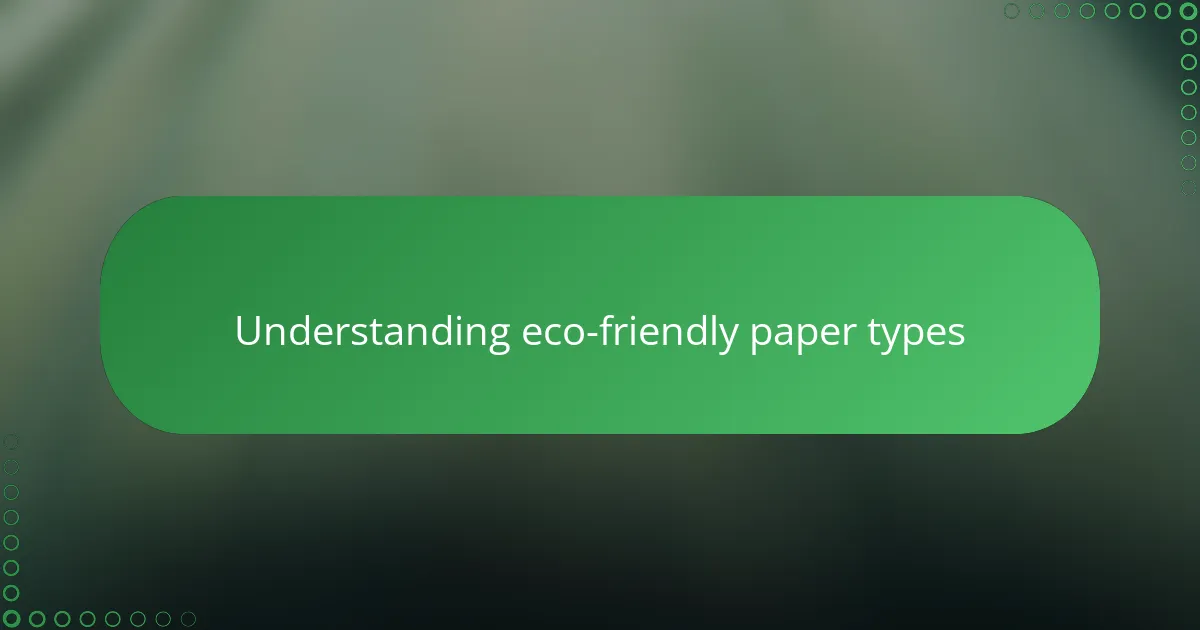
Understanding eco-friendly paper types
When I first started exploring eco-friendly paper options, I quickly realized there aren’t just one or two types to consider but a whole spectrum. From recycled paper to those made from agricultural waste like hemp or bagasse, each offers unique textures and environmental benefits. Have you ever paused to think about where your paper actually comes from before crafting?
I find it fascinating how recycled paper often breathes new life into discarded materials, turning what was once waste into something beautiful and tangible. It feels like a small victory against the mountain of trash we generate daily. But even within recycled options, there are grades that vary in quality, so you really have to decide what’s most important for your project—durability or eco-impact?
Then there’s the intriguing world of alternative fiber papers, made from plants that don’t require heavy pesticide use or excessive water. Using these feels like honoring nature’s own cycles, doesn’t it? I’ve personally grown fond of handmade hemp paper because it carries this raw, authentic vibe while reducing the strain on forests. It made me rethink how my crafting choices align with my values, and it might do the same for you.
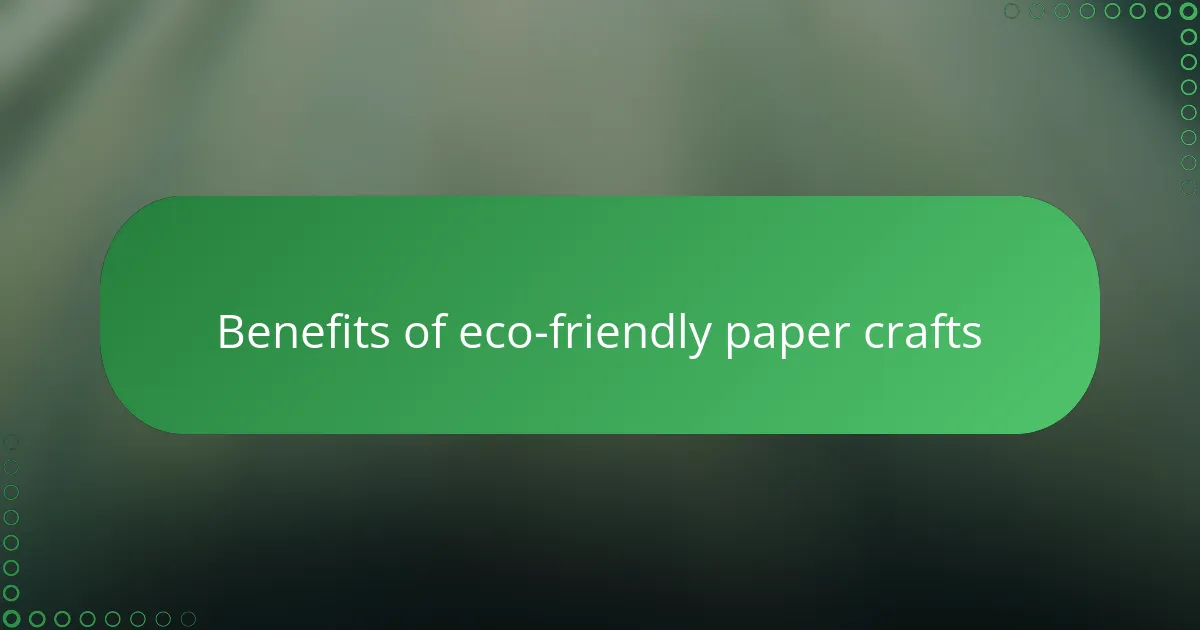
Benefits of eco-friendly paper crafts
One of the biggest benefits I’ve noticed with eco-friendly paper crafts is the sense of connection they create—with both nature and the process itself. Working with materials that are thoughtfully sourced or recycled makes every cut and fold feel more meaningful. Have you ever sensed that your craft could actually contribute to a healthier planet? That feeling keeps me coming back to eco-friendly choices.
Another aspect I appreciate is how these papers often bring unique textures and character to my projects that conventional paper just can’t match. There’s something wonderfully imperfect and organic about handmade hemp or bagasse paper that sparks my creativity in unexpected ways. It’s like the paper’s own story weaves into mine, adding depth beyond the visual.
Finally, choosing eco-friendly papers means supporting practices that reduce waste and conserve resources. It’s not just about the look or feel; it’s about standing behind a craft that respects the environment. When I think about the impact of my small decisions, it’s empowering to know that every scrap of recycled paper I use helps close a loop rather than open another landfill. Does that responsibility make your crafting feel more purposeful too?
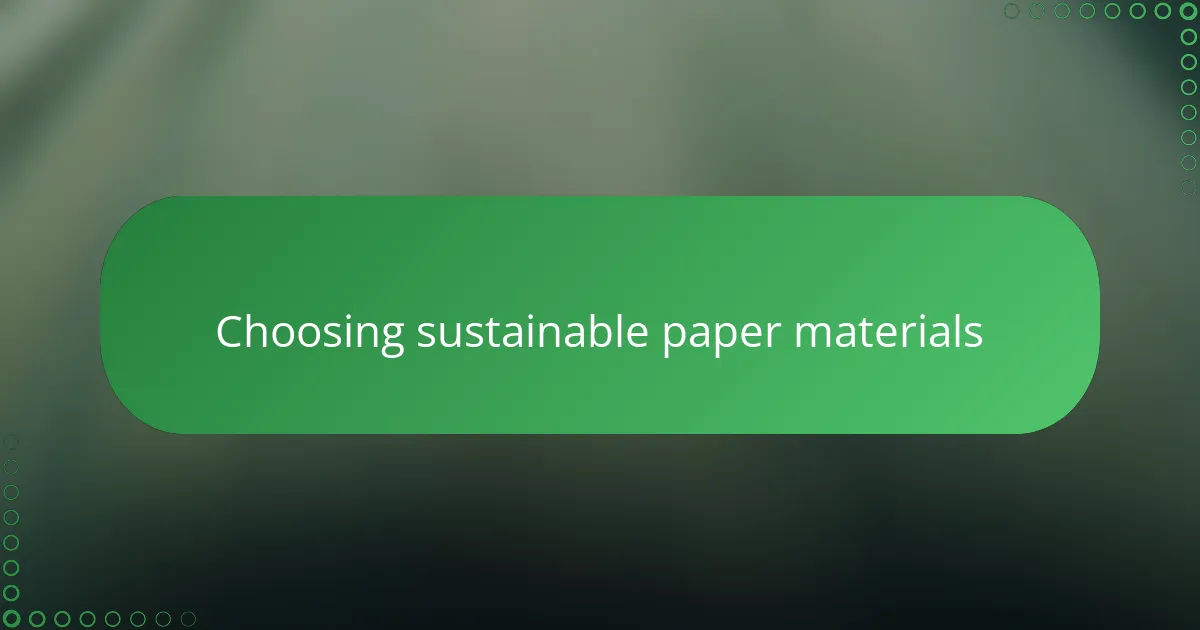
Choosing sustainable paper materials
When I’m choosing sustainable paper materials, I always ask myself how much the process behind that paper aligns with my values. Does it come from responsibly managed forests or agricultural leftovers that would otherwise go unused? Knowing that my choice supports these cycles makes me feel like I’m crafting with intention, not just convenience.
Sometimes, I remember the first time I held a sheet of paper made from bagasse, the leftover sugarcane fibers. It felt different—lighter and somehow more alive—compared to the dull, mass-produced options I was used to. That tactile difference reminds me that sustainable materials carry more than texture; they carry stories and purpose I want to share through my work.
How often do we pause to consider the full life cycle of the paper in our crafts? For me, picking materials that reduce water use or chemical treatments feels like a quiet rebellion against wasteful habits. It’s not always easy, but each choice nudges me closer to a craft practice that respects the earth.
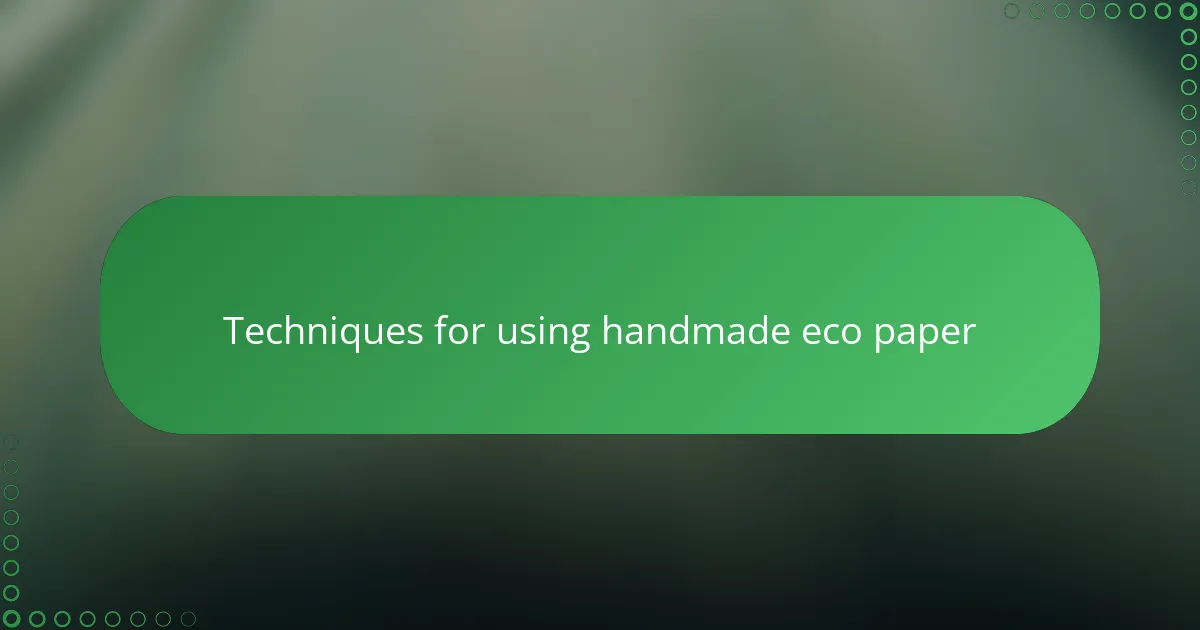
Techniques for using handmade eco paper
Working with handmade eco paper demands a gentle touch—I’ve learned that pressing too hard can flatten the paper’s unique fibers, dulling its rich texture. Have you noticed how folding it slowly, almost reverently, preserves that natural, earthy feel that sets these papers apart from factory-made ones?
I often experiment with layering techniques, using thin sheets to build up depth and a tactile sense that mimics natural landscapes or organic patterns. It’s almost like painting, but with paper—you get to shape not just the image, but the very surface you’re working on, making each piece deeply personal and alive.
Another trick I swear by is embracing the paper’s imperfections instead of hiding them. Those flecks and uneven edges tell a story of sustainability and craftsmanship, don’t they? Instead of smoothing them out, I highlight these quirks with careful use of light or contrasting materials, turning every flaw into a focal point.
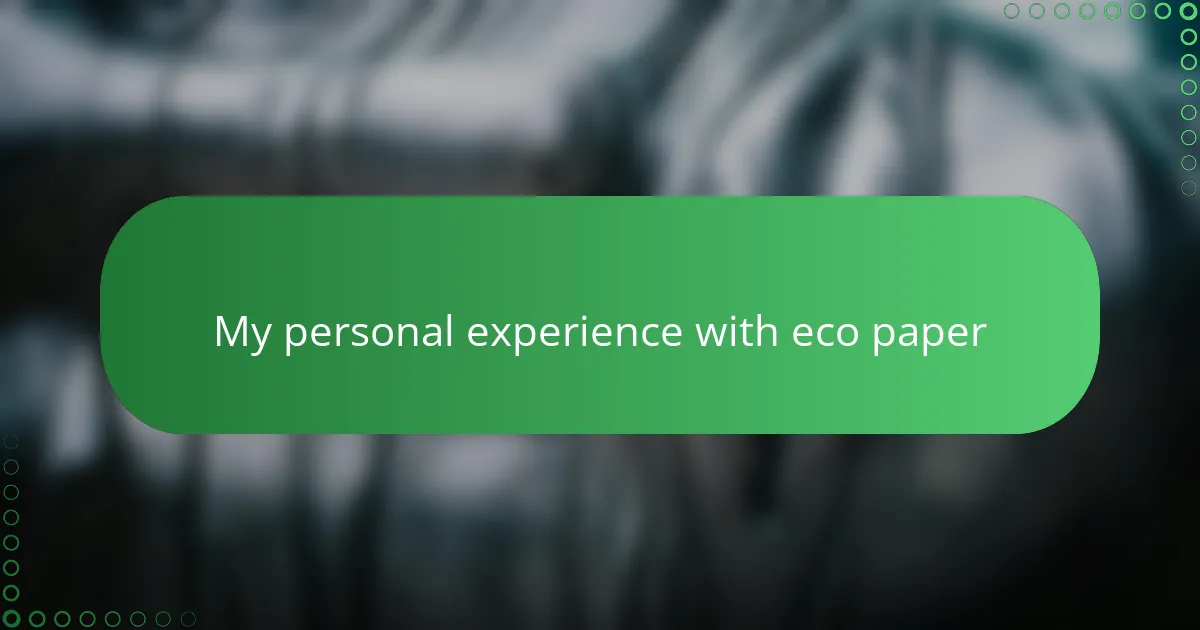
My personal experience with eco paper
My first encounter with eco-friendly paper was a mix of curiosity and surprise. I remember nervously tearing into a sheet of recycled paper, wondering if it would handle my tools well—and to my delight, it did. That moment made me realize eco paper isn’t just a compromise; it’s an invitation to explore new textures and storytelling in my crafts.
There was also a time when I switched entirely to hemp paper for a special project. The fibers felt so alive, and working with that paper gave me a sense of calm and connection that I hadn’t expected. Have you ever found that a simple material can shift your whole creative mindset? For me, eco paper wasn’t just eco-friendly—it was inspiring.
Of course, it hasn’t always been perfect. I’ve had sheets that frayed unexpectedly or required more patience to fold just right. But those challenges made me appreciate the handmade quality even more. Isn’t crafting partly about embracing those little quirks and learning from them? Using eco paper continually reminds me why I cherish the handmade process so deeply.
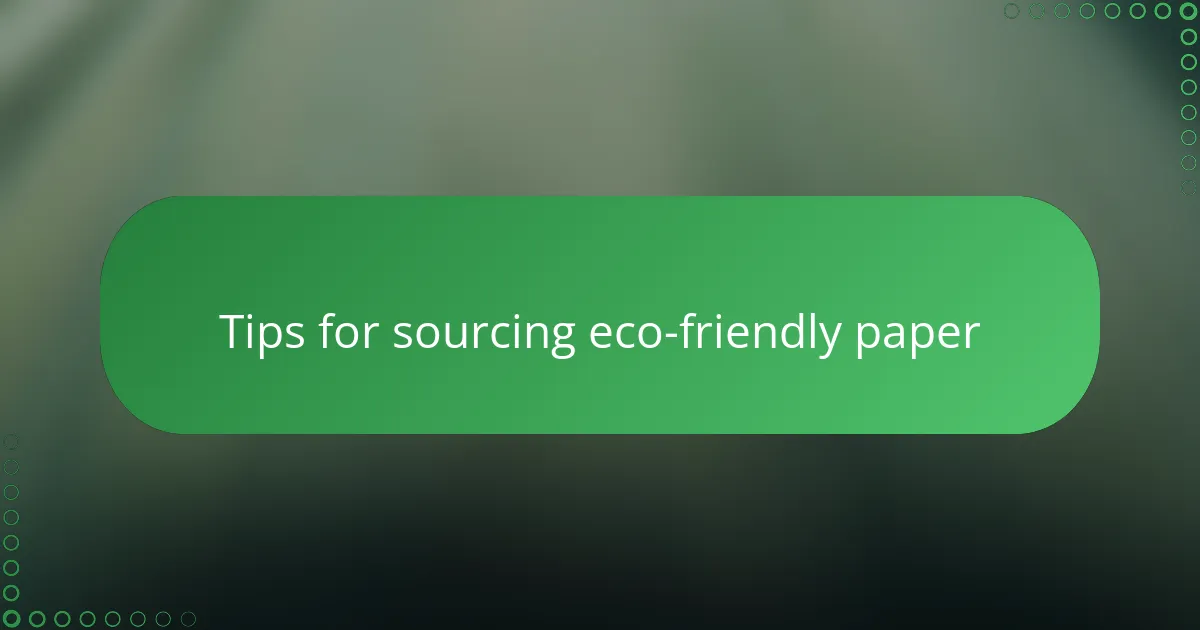
Tips for sourcing eco-friendly paper
Finding trustworthy sources for eco-friendly paper can be a bit like embarking on a treasure hunt. I always start by looking for certifications like FSC or Green Seal, which reassure me that the paper comes from well-managed forests or recycled materials. Have you ever felt that extra confidence knowing your paper choice is backed by a credible standard?
Sometimes, I rely on local artisans or small businesses who specialize in handmade paper. Their stories and transparency about sourcing add a personal touch that big brands often lack. It’s rewarding to support these creators who share my passion for sustainability and craft.
Don’t hesitate to ask questions when shopping—about fiber origins, bleaching processes, or chemical treatments. In my experience, vendors who welcome these inquiries often supply paper with genuine eco-credentials. It makes me feel part of a thoughtful community rather than just a consumer. Have you tried this approach before? It can open doors to discovering truly special materials.
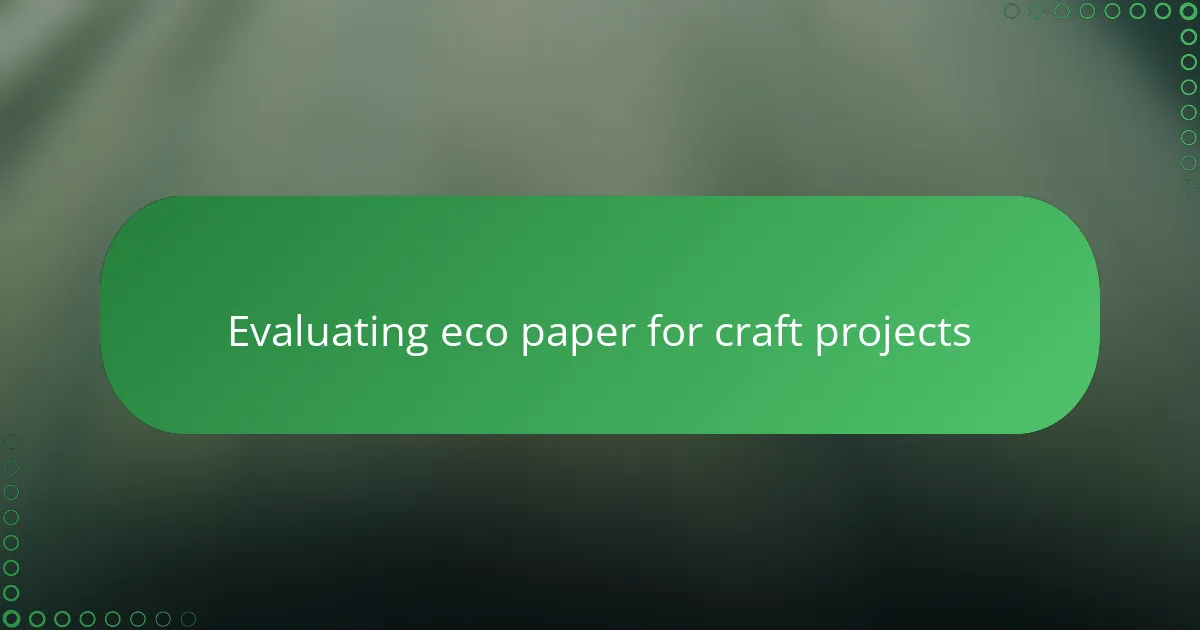
Evaluating eco paper for craft projects
When I evaluate eco paper for my craft projects, the first thing I look for is how well it holds up to cutting, folding, and gluing. Have you ever been frustrated when a beautiful sheet tears or wrinkles too easily? For me, finding that balance between eco-friendliness and practical durability can make or break the creative flow.
I also pay close attention to the paper’s texture and weight because these qualities hugely influence the final look and feel. Sometimes, a rougher surface adds character but can be tricky to write or paint on, while a smoother finish might limit the natural charm I’m seeking. Choosing the right eco paper has become almost like selecting a creative partner—one that supports and enhances my artistic vision.
Lastly, I consider the paper’s origin and processing methods; knowing that it came from sustainable sources or minimal chemical use makes me craft with a lighter heart. Do you ever feel that knowing the story behind your materials deepens your connection to the project? For me, it transforms a simple craft into an act of respect for the environment.
